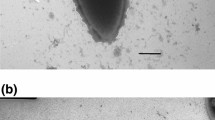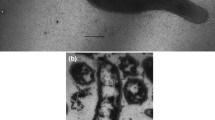Abstract
A novel anaerobic, alkaliphilic, Gram-positive staining bacterium was isolated from a hydrothermal chimney in the Prony Bay, New Caledonia. This strain designated FatMR1T grew at temperatures from 20 to 55 °C (optimum 37 °C) and at pH between 7.5 and 10.5 (optimum 8.8–9). NaCl is not required for growth (optimum 0.2–0.5 %), but is tolerated up to 3 %. Sulfate, thiosulfate, elemental sulfur, sulfite, nitrate and nitrite are not used as terminal electron acceptors. Strain FatMR1T fermented pyruvate, yeast extract, peptone and biotrypcase and used fructose as the only sugar. The main fermentation products from fructose and proteinaceous compounds (e.g. peptone and biotrypcase) were acetate, H2 and CO2. Crotonate was disproportionated to acetate and butyrate. The predominant cellular fatty acids were C14:0 and C16:0. The G + C content of the genomic DNA was 37.1 mol %. On the basis of phylogenetic, genetic, and physiological properties, strain FatMR1T (=DSM 25890T, =JCM 18390T) belonging to the phylum Firmicutes, class Clostridia, order Clostridiales, is proposed as a novel species of the genus Alkaliphilus, A. hydrothermalis sp. nov.



Similar content being viewed by others
References
Altschul SF, Gish W, Miller W, Myers EW, Lipman DJ (1990) Basic local alignment search tool. J Mol Biol 215:403–410
Balch WE, Fox GE, Magrum RJ, Wolfe RS (1979) Methanogens: re-evaluation of a unique biological group. Microbiol Rev 43:260–296
Ben Aissa F, Postec A, Erauso G, Payri C, Pelletier B, Hamdi M, Ollivier B, Fardeau ML (2014) Vallitalea pronyensis sp. nov., isolated from a marine alkaline hydrothermal chimney. Int J Syst Evol Microbiol 64:1160–1165
Brazelton WJ, Schrenk MO, Kelley DS, Baross JA (2006) Methane-and sulfur-metabolizing microbial communities dominate the Lost City hydrothermal field ecosystem. Appl Environ Microbiol 72:6257–6270
Brazelton WJ, Ludwig KA, Sogin ML, Andreishcheva EN, Kelley DS, Shen CC, Edwards RL, Baross JA (2010) Archaea and bacteria with surprising microdiversity show shifts in dominance over 1,000-year time scales in hydrothermal chimneys. Proc Natl Acad Sci USA 107:1612–1617
Cao X, Liu X, Dong X (2003) Alkaliphilus crotonatoxidans sp. nov., a strictly anaerobic, crotonate-dismutating bacterium isolated from a methanogenic environment. Int J Syst Evol Microbiol 53:971–975
Cashion P, Holder-Franklin MA, McCully J, Franklin M (1977) A rapid method for the base ratio determination of bacterial DNA. Annal Biochem 81:461–466
Collins MD, Lawson PA, Willems A, Cordoba JJ, Fernandez-Garayzabal J, Garcia P, Cai J, Hippe H, Farrow JAE (1994) The phylogeny of the genus Clostridium: proposal of five new genera and eleven new species combinations. Int J Syst Bacteriol 44:812–826
Cord-Ruwisch R (1985) A quick method for the determination of dissolved and precipitated sulfides in cultures of sulfate-reducing bacteria. J Microbiol Methods 4:33–36
De Ley J, Cattoir H, Reynaerts A (1970) The quantitative measurement of DNA hybridization from renaturation rates. Eur J Biochem 12:133–142
Edgar RC (2004) MUSCLE: multiple sequence alignment with high accuracy and high throughput. Nucl Acids Res 32:1792–1797
Fardeau ML, Ollivier B, Patel BK, Magot M, Thomas P, Rimbault A, Rocchiccioli F, Garcia JL (1997) Thermotoga hypogea sp. nov., a xylanolytic, thermophilic bacterium from an oil-producing well. Int J Syst Bacteriol 47:1013–1019
Fardeau ML, Magot M, Patel BK, Thomas P, Garcia JL, Ollivier B (2000) Thermoanaerobacter subterraneus sp. nov., a novel thermophile isolated from oil field water. Int J Syst Evol Microbiol 6:2141–2149
Hungate RE (1969) A roll-tube method for the cultivation of strict anaerobes. Methods Microbiol 3B:117–132
Huß VA, Festl H, Schleifer KH (1983) Studies on the spectrophotometric determination of DNA hybridization from renaturation rates. Syst Appl Microbiol 4:184–192
Kelley DS, Karson JA, Blackman DK, Früh-Green GL, Butterfield DA, Lilley MD, Olson EJ, Schrenk MO, Roe KK, Lebon GT, Rivizzigno P, AT3-60 Shipboard Party (2001) An off-axis hydrothermal vent field near the Mid-Atlantic Ridge at 30 degrees N. Nature 412:145–149
Khelifi N, Ben Romdhane E, Hedi A, Postec A, Fardeau M-L, Hamdi M, Tholozan J-L, Ollivier B, Hirschler-Réa A (2010) Characterization of Microaerobacter geothermalis gen. nov., sp. nov., a novel microaerophilic, nitrate- and nitrite-reducing thermophilic bacterium isolated from a terrestrial hot spring in Tunisia. Extremophiles 14:297–304
Kuykendall LD, Roy MA, O´Neil JJ, Devine TE (1988) Fatty acids, antibiotic resistance, and desoxyribonucleic acid homology groups of Bradyrhizobium japonicum. Int J Syst Bacteriol 38:358–361
Launay J, Fontes JC (1985) Les sources thermales de Prony (Nouvelle-Calédonie) et leurs précipités chimiques: exemple de formation de brucite primaire. Géologie de la France 83–100
Mesbah M, Premachandran U, Whitman WB (1989) Precise measurement of the G + C content of deoxyribonucleic acid by high-performance liquid chromatography. Int J Syst Bacteriol 39:159–167
Miller LT (1982) Single derivatization method for routine analysis of bacterial whole-cell fatty acid methyl esters, including hydroxy acids. J Clin Microbiol 16:584–586
Monnin C, Chavagnac V, Boulart C, Ménez B et al (2014) The low temperature hyperalkaline hydrothermal system of the Prony bay (New Caledonia). Biogeosciences Discuss 11(4):6221–6267
Pelletier B, Chevillon C, Menou J, Butscher J, Folcher E et al. (2006) Plongées, forage et cartographie Baie du Prony et Banc Gail, lagon Sud de Nouvelle-Calédonie, campagne 2005-NC-PL du N.O. ALIS 13–17 Juin 2005 et cartographie baie du Prony et canal Woodin N.O. ALIS 25–26 September 2005: Nouméa IRD Sept. 2006. Missions Sci Terre, Géol-Géophys 70:44
Quéméneur M, Bes M, Postec A, Mei N et al. (2014) Spatial distribution of microbial communities in the shallow submarine alkaline hydrothermal field of the Prony Bay, New Caledonia. Environ Microbiol Rep (in press)
Russell MJ, Hall AJ, Martin W (2010) Serpentinization and its contribution to the energy for the emergence of life. Geobiol 8:355–371
Schrenk MO, Kelley DS, Bolton SA, Baross JA (2004) Low archaeal diversity linked to subseafloor geochemical processes at the Lost City hydrothermal field, Mid-Atlantic Ridge. Environ Microbiol 6:1086–1095
Schrenk MO, Brazelton WJ, Lang SQ (2013) Serpentinization, carbon, and deep life. Rev Mineral Geochem 75:575–606
Takai K, Moser DP, Onstott TC, Spoelstra N, Pfiffner SM, Dohnalkova A, Fredrickson JK (2001) Alkaliphilus transvaalensis gen. nov., sp. nov., an extremely alkaliphilic bacterium isolated from a deep South African gold mine. Int J Syst Evol Microbiol 51:1245–1256
Tamura K, Nei M, Kumar S (2004) Prospects for inferring very large phylogenies by using the neighbor-joining method. Proc Natl Acad Sci (USA) 101:11030–11035
Tamura K, Peterson D, Peterson N, Stecher G, Nei M, Kumar S (2011) MEGA5: molecular evolutionary genetics analysis using maximum likelihood, evolutionary distance, and maximum parsimony methods. Mol Biol Evol 28:2731–2739
Wayne LG, Brenner DJ, Colwell RR, Grimont PAD, Kandler P, Krichevsky MI, Moore LH, Murray RGE, Stackebrandt E, Starr MP, Trüper HG (1987) Report of the ad hoc committee on reconciliation of approaches to bacterial systematics. Int J Syst Bacteriol 37:463–464
Wu XY, Shi KL, Xu XW, Wu M, Oren A, Zhu XF (2010) Alkaliphilus halophilus sp. nov., a strictly anaerobic and halophilic bacterium isolated from a saline lake, and emended description of the genus Alkaliphilus. Int J Syst Evol Microbiol 60:2898–2902
Acknowledgments
We would like to thank Manon Joseph for electron microscopy photographs. We thank Régis Hocdé and Jean-Louis Menou for sampling by scubadiving in Prony Bay.
Author information
Authors and Affiliations
Corresponding author
Additional information
Communicated by A. Oren.
Rights and permissions
About this article
Cite this article
Ben Aissa, F., Postec, A., Erauso, G. et al. Characterization of Alkaliphilus hydrothermalis sp. nov., a novel alkaliphilic anaerobic bacterium, isolated from a carbonaceous chimney of the Prony hydrothermal field, New Caledonia. Extremophiles 19, 183–188 (2015). https://doi.org/10.1007/s00792-014-0697-y
Received:
Accepted:
Published:
Issue Date:
DOI: https://doi.org/10.1007/s00792-014-0697-y




